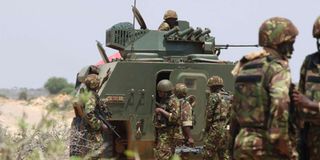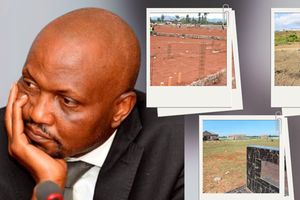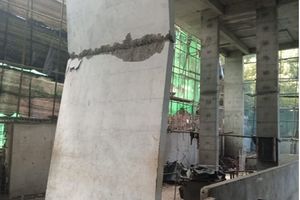Premium
Let’s be the leopard, not the sheep

Kenya Defence Forces soldiers under Africa Union Mission in Somalia (Amisom) patrol Kismayo town on November 22, 2015. It appears we are the sheep, Al-Shabaab the leopard. The terror has returned to northern Kenya, blowing up police vehicles, bringing down cellphone masts and doing its best to destroy the country.
It appears we are the sheep, Al-Shabaab the leopard. The terror has returned to northern Kenya, blowing up police vehicles, bringing down cellphone masts and doing its best to destroy the country.
Since Al-Shabaab’s intention is to cause communal division and religious war in Kenya, they don’t appear to harass the local community too much, targeting, instead, law enforcement, infrastructure and upcountry folk when they can.
Terrorism and the flow of insecurity from Somalia should be seen as the new normal. Somalia has been without a proper, stable government for 32 years after the collapse of the Gen Mohamed Siad Barre regime in 1991.
Much effort has been invested by the leaders of Somalia and the country’s partners to stabilise it and give it a good, functioning government. But that has been successful only to a degree. There is an ongoing full-blown insurgency, resulting in the slaughter of innocent folk in Somalia and even elsewhere in the region.
Last month, the terror group killed 54 Ugandan peacekeepers in Shebelle. On January 15, 2016, they overrun the KDF Forward Operating Base at El Ade and killed an estimated 141 soldiers—possibly the worst Kenyan war loss since the Mau Mau in the 1950s. Before that, they had hit a Ugandan base on September 21, 2015, and a Burundian one on June 26 that year.
I don’t need to go into the gory details but Al-Shabaab has operated in East African cities, primarily Kenya, slaughtering university students and staging highly publicised and severely damaging mall sieges and shooting dozens of shoppers.
Of course, this activity is a serious threat to our existence and we will not blink our eyes to have it disappear. As a matter of fact, there is scant reason to assume it couldn’t get worse with these characters shifting base more or less from Somalia and into Kenya amid the so-called crackdown. So, what type of country and region will our children and their children live in? And what should they do? Lie down and die? How should they protect themselves and their homeland from this danger that refuses to die? Let me shift gears.
My paternal grandfather, Mr M’Ndira Nyonta, of the Mbuya clan, was a renegade. He went against the grain even in the simplest of ways. When the rest of the world was moving forward, he was one of the few people in our village who did not make the transition from African tribesman to Westernised African.
He never went to school, couldn’t read, and didn’t give a hoot. He never converted to Christianity or, indeed, any religion. He remained a pastoralist, depending on milk and blood from his cattle, supplemented by a few traditional crops like yams, arrow roots, cassava and sweet potato, when the rest of us settled for modern agriculture.
Fully autonomous
Even in his eighties and nineties, my grandfather was fully autonomous. Well, he had two dinners every night. He would eat his own food (mainly ugali and roasted stuff that I was banned from eating but which I relished) washed down with dinner from my mother’s kitchen, such as rice, mashed potato and such light foods. He roamed the forests and our homeland with his cattle, unafraid of wild animals and other dangers.
If he wanted to go to Nanyuki, he would walk, keeping close to the forests. Beneath his long coat was an armoury—knives, swords and fighting sticks—and a canteen (roast yams, bananas, sweet potato and cassava wrapped in banana leaves, gourds of fermented milk, perhaps even some bread). And he would live off the land, visiting relatives and eating what was available, such as berries and wild fruit. I’m certain he would have operated deep into Samburu and Isiolo, if he needed to, and survived fighting off animals and the occasional, unwise human.
Culture supported the development of that type of autonomous person—at home with arms, able to survive off the land for extended periods. We caught the dying embers of this culture during the initiation of our generation, where boys were circumcised and secluded at the age of 13 or 14. They learnt to deal with fear and to form bonds that were stronger than kinship. Even though martial training had already been lost, it was a toughness and confidence inculcated in these young people that was good raw material.
Today, boys are given to the church for circumcision. Where traditional culture produced fearsome warriors and masters of the land, to whom a fight, whether with an adversary or animal, was second nature, today we produce beautiful, peaceful, broken sheep, prey for Al-Shabaab and other predators.
Even as an old man, if Al-Shabaab had attacked our village, I’m sure it probably would not have occurred to my grandfather and his generation to call the police, army, the chief or some joker like that. He would have hunted them. With poisoned arrows, spears, swords and all manner of native trickery. The police and army can’t be everywhere. If we are to survive as a species, we must recover our culture of preparing citizens to protect themselves, their families and communities.
How long do you think an Al-Shabaab squad would last in Suguta Valley? How many villagers would they slaughter in Kapedo? Not to support banditry, but they would be the sheep, not the leopard.




